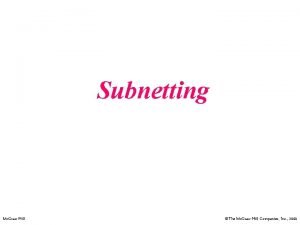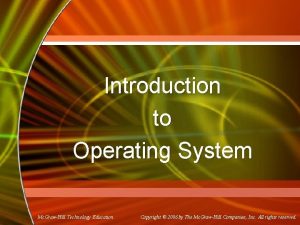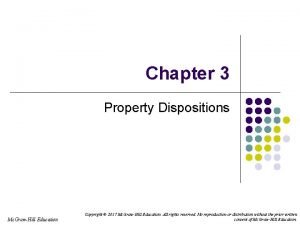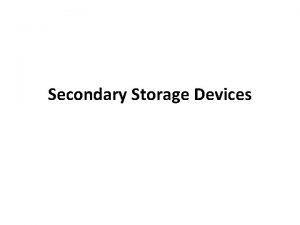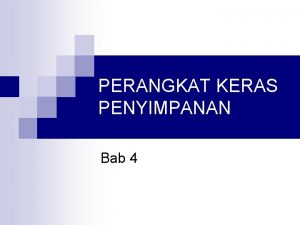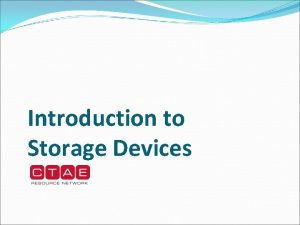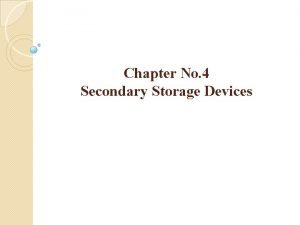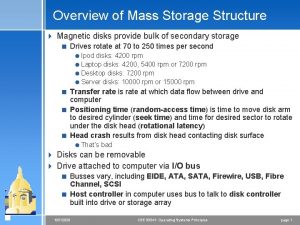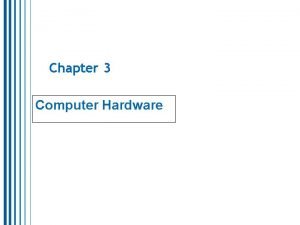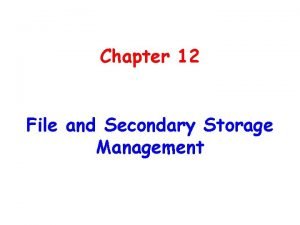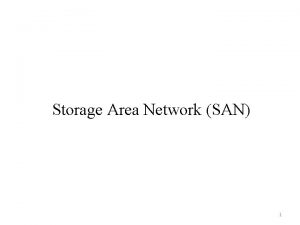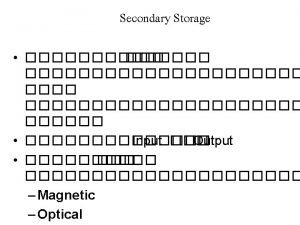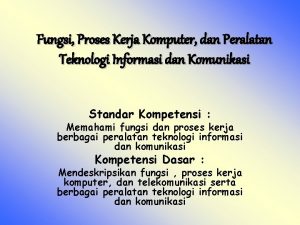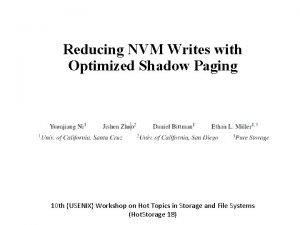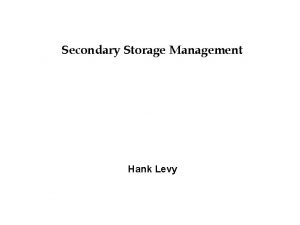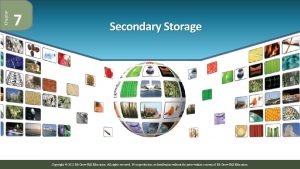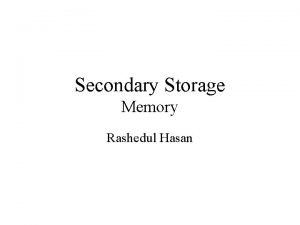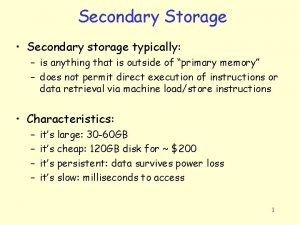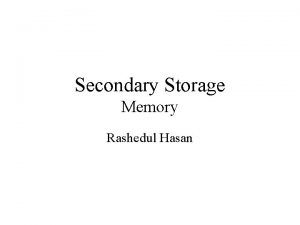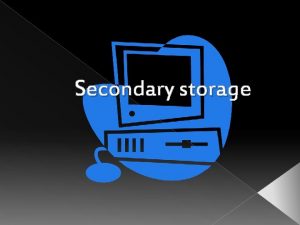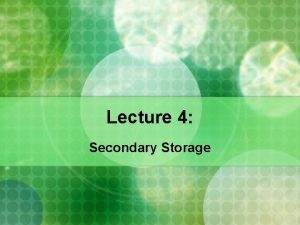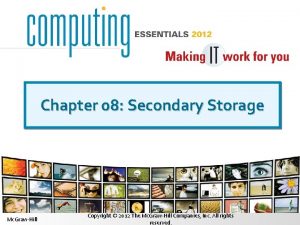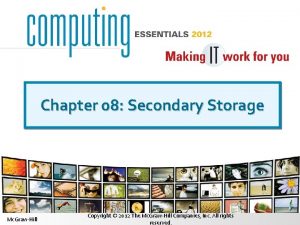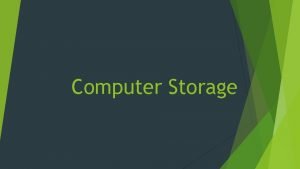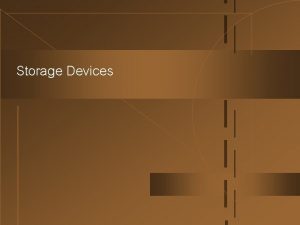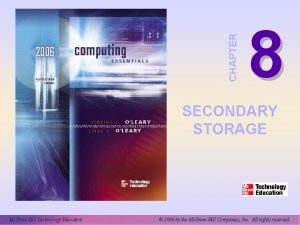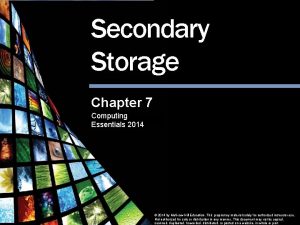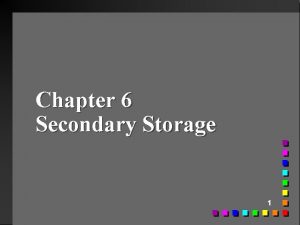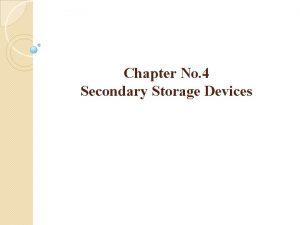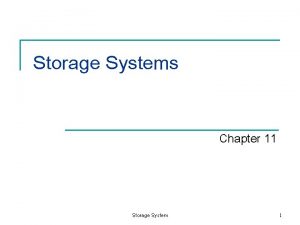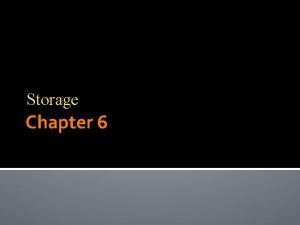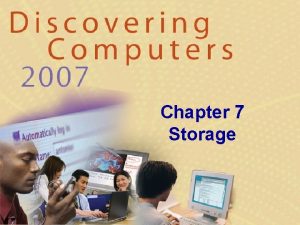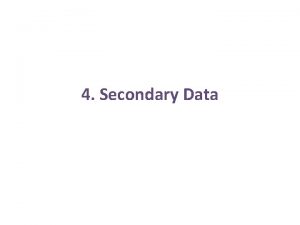Chapter 7 Secondary Storage Copyright 2015 Mc GrawHill






























- Slides: 30

Chapter 7 Secondary Storage Copyright © 2015 Mc. Graw-Hill Education. All rights reserved. No reproduction or distribution without the prior written consent of Mc. Graw-Hill Education.

Learning Objectives 1. Distinguish between primary and secondary storage. 2. Identify the important characteristics of secondary storage, including media, capacity, Computing Essentials 2015 3. 4. 5. 6. 7. 8. 9. storage devices, and access speed. Describe hard disk platters, tracks, sectors, cylinders, and head crashes. Compare internal and external hard drives. Compare performance enhancements including disk caching, RAID, file compression, and file decompression. Define optical storage including compact discs, digital versatile discs, and Blu-ray discs. Define solid-state storage, including solid-state drives, flash memory cards, and USB drives. Define cloud storage and cloud storage services. Describe mass storage, mass storage devices, enterprise storage systems, and storage area networks. 7 -2

Introduction • Data storage has expanded from text and numeric files to include digital music files, Computing Essentials 2015 photographic files, video files, and much more. • These new types of files require secondary storage devices with much greater capacity. • In this chapter, you learn about the many types of secondary storage devices including their capabilities and limitations. 7 -3

1. Storage • Primary storage • Volatile storage • Temporary storage • Random Access Memory Computing Essentials 2015 (RAM) • Secondary storage • Nonvolatile storage • Permanent storage • Secondary storage characteristics • Media • Capacity • Storage devices • Access speed 7 -4

2. Hard Disks Computing Essentials 2015 • Use rigid, metallic platters that are stacked one on top of one another • Store and organize files using tracks, sectors, and cylinders • Susceptible to head crash How charges on a disk surface store the letter A Tracks and Sectors 7 -5

Head Crash • Occurs when read-write head makes contact with the hard disk’s surface Computing Essentials 2015 or with particles on its surface • Disastrous 7 -6

Types of Hard Disks Computing Essentials 2015 Internal • Located inside system unit • Used to store programs and data files External • Removable • Used to complement internal hard disk 7 -7

Hard Disks See figure 7 -4 Computing Essentials 2015 Hard disks are sensitive instruments. Their read/write heads ride on a cushion of air about 0. 000001 inch tick 7 -8

Performance Enhancements Computing Essentials 2015 • Disk caching to improve hard disk performance • Redundant arrays of inexpensive disks (RAID) to expand storage and to improve access speed • File compression and decompression to increase capacity 7 -9

(Note on RAID) What are the benefits of RAID 1. Expanded storage capability 2. Fast access speed 3. High reliability Computing Essentials 2015 For these reasons RAID is often used by internet servers and large organizations 7 -10

(Note on File compression and file decompression pg 175) Computing Essentials 2015 File compression increases storage capacity by reducing the amount of space required to store data and programs…. File compression programs scan files for ways to reduce the amount required storage… These programs often shrink files to a …… 7 -11

(Note on File compression and file decompression pg 175) Computing Essentials 2015 File Decompression ? 7 -12

(Note on Summary of performance enhancement techniques pg 175 ) Insert table (pg 175) Computing Essentials 2015 DO your concept check (pg 176) 7 -13

3. Optical Discs Computing Essentials 2015 • In optical disk technology a laser beam alters the surface of a plastic or metallic disc to represent data. Unlike hard disks, which uses magnetic charges to represent 0 s and 1 s optical disks use reflected light • The 1 s and 0 s are represented by flat areas called lands and bumpy areas called pits on the disk surface • The disk is read by an optical disc drive using a laser that projects a tiny beam of light on these areas. The amount of reflected light determines whether the area represents a 1 or a 0 (pg 176) 7 -14

3. Optical Discs Computing Essentials 2015 • Hold over 128 gigabytes (GB) of data • Attributes • Lands • Pits • Three types (these are the most widely used) • Compact Disc (CD) • Digital Versatile Disc (DVD) • Blu-Ray Disc (BD) 7 -15

Compact Disc (CDs) Computing Essentials 2015 • Optical format • Capacity of 700 MB on data on one side • Three basic types • Read only (CD-ROM) • Write once (CD-R) • Rewriteable (CD-RW) Return 7 -16

Digital Versatile Discs (DVDs) • Like CDs, but newer format called digital versatile disc or digital video disc (DVD) • Capacity of 4. 7 GB on one side (how many 100 MB CDs) • Three basic types Computing Essentials 2015 • Read only (DVD-ROM) • Write once (DVD+R and DVD-R) • Rewriteable (DVD+RW, DVD-RW, and DVD-RAM) Return 7 -17

4. Solid-State Storage • Solid–state drives (SSDs) • No moving parts • Faster and more durable than hard disks • Flash memory cards • Widely used in laptops, smartphones, GPS Computing Essentials 2015 navigation systems • USB Drives (or Flash Drives) • Connect to USB port • Capacity of 1 GB to 256 GB 7 -18

Blu-ray Disc (BDs) • While CDs and DVDs represent the past and the present for optical disc storage, the future belongs to discs of even greater capacity (pg 177) Computing Essentials 2015 • Next generation optical disc for recording high-definition (hi def) video • Capacity of 50 GB on one side • Blu-ray optical drives are usually capable of reading standard DVDs and CDs in addition to Blu-ray discs (do concept check pg 178) 7 -19

5. Cloud Computing • Cloud computing is where the Internet acts as a “cloud” of servers • Applications provided as a service rather than a product • Supplied by servers Computing Essentials 2015 • Google Drive Docs • Mint. com • (Note google Google Docs) Google Drive Docs 7 -20

Cloud Storage Services Online Storage Benefits / Advantages • Maintenance • Hardware upgrades • File sharing and collaboration Computing Essentials 2015 Disadvantages • Access speed • File Security 7 -21

Making IT Work for You ~ Cloud Storage Computing Essentials 2015 • Using a cloud storage service makes it easy to upload and share files with anyone. Getting Started The Dropbox Folder Getting More Storage Space 7 -22

Mass Storage Devices • Large amounts of secondary storage requirements • Enterprise storage system • Safe use of data across an organizational network Computing Essentials 2015 • Devices include: • File servers • Networked attached storage (NAS) • RAID systems • Organizational cloud storage 7 -23

Storage Area Network (SAN) Computing Essentials 2015 • Architecture to link remote computer storage devices • Enterprise storage systems • Computers to provide local system access • User’s computer provides file system, but SAN provides disk space • House data in remote locations and still allow efficient and secure access 7 -24

Careers In IT • Disaster recovery specialists are responsible for recovering systems and data after a disaster strokes • General employer requirements • Bachelors degree in Computing Essentials 2015 computer science • Extensive knowledge of computers and technology • Communication and analytical skills • Annual salary of $70, 000 to $103, 000 7 -25

A Look to the Future ~ Next Generation Storage • At some point, hard drives will Computing Essentials 2015 no longer be able to keep up • Looking at ways of increasing capacity without increasing size • Currently hard drive maxes out at 128 GB per square inch. • New technologies may advance this to 6. 25 TG (6, 250 GB) per square inch. 7 -26

Open-Ended Questions (Page 1 of 2) 1. Compare primary storage and secondary storage, and discuss the most important characteristics of secondary storage. 2. Discus hard disks including density, platters, tracks, sectors, cylinders, head Computing Essentials 2015 crashes, internal, external, and performance enhancements. 3. Discuss optical disks including pits, lands, CDs, DVDs, Blu-ray, and hi def. 7 -27

Open-Ended Questions (Page 2 of 2) 4. Discuss solid-state storage including solid-state drives, flash memory, and USB drives. Computing Essentials 2015 5. Discuss cloud computing and cloud storage. 6. Describe mass storage devices including enterprise storages systems, file servers, network attached storage, RAID systems, organizational cloud storage, and storage area network systems. 7 -28

Capacity Brand Price 1 GB Lexmar $5. 00 2 GB 4 GB Computing Essentials 2015 8 GB 16 GB 32 GB 256 GB 7 -29

Capacity Brand Price 64 GB Lexmar $5. 00 128 GB Computing Essentials 2015 256 GB 7 -30
 Primary storage vs secondary storage
Primary storage vs secondary storage Storage devices of computer
Storage devices of computer Secondary storage provides temporary or volatile storage
Secondary storage provides temporary or volatile storage Grawhill
Grawhill Grawhill
Grawhill Grawhill
Grawhill Grawhill
Grawhill Mc grawhill
Mc grawhill Single user multitasking os
Single user multitasking os Grawhill
Grawhill Mc grawhill
Mc grawhill Grawhill
Grawhill Copyright 2015 all rights reserved
Copyright 2015 all rights reserved Copyright 2015 all rights reserved
Copyright 2015 all rights reserved Copyright secondary sara (2017) answers
Copyright secondary sara (2017) answers Object based and unified storage
Object based and unified storage Secondary storage devices
Secondary storage devices Magnetic tape secondary storage device
Magnetic tape secondary storage device Contoh secondary storage
Contoh secondary storage Introduction to storage
Introduction to storage Inkjet or laser printer
Inkjet or laser printer Mass storage structure
Mass storage structure Secondary storage device
Secondary storage device Secondary storage management
Secondary storage management Storage area network definition
Storage area network definition Magnetic disk
Magnetic disk Unit penyimpanan dapat diartikan sebagai
Unit penyimpanan dapat diartikan sebagai Secondary storage
Secondary storage Offal define
Offal define Chapter 19 food safety and storage activity 1 answers
Chapter 19 food safety and storage activity 1 answers Iso 9001:2015 ppt
Iso 9001:2015 ppt






